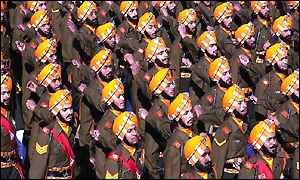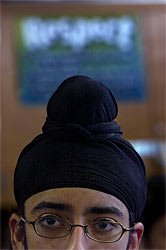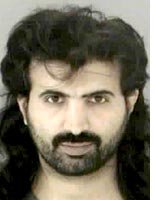Thursday, April 27, 2006
Sunday, April 23, 2006
Using MySpace for Evidence of Hate Crimes
 According to the Associated Press: According to the Associated Press: When high school teacher Lee Waters logged on to a popular Web site and read the demeaning sexual comments a student had posted alongside her picture, the Sarasota woman felt completely degraded.
The school district suspended the North Port High School student, but attorney Geoffrey Morris said Waters doesn't think the boy understands the humiliation she feels.
The teacher filed a lawsuit against the student in March, but she isn't looking for money. She just wants other students to understand how harmful Internet pranks can be, Morris said.
"This teacher was maligned by this kid," Morris said. "She was so upset about it and she filed this lawsuit because she says teaching is a profession and that the administration turned their back on her complaint."
The Sarasota County School District said it did what it could to help Waters by suspending the student and taking other disciplinary action, but it's not alone as it struggles to deal with cyber-bullying. Similar lawsuits and complaints are popping up in Florida and elsewhere nationwide as bullies move from punching someone on the playground to writing nasty and sometime libelous postings about classmates, teachers and school officials on the Internet, where everyone can read them.
Public and private schools have launched cyber-crackdowns on the bullies, but that has left them vulnerable to accusations that they are violating the students' First Amendment rights, particularly when the posting is made on an off-campus computer as most are. The American Civil Liberties Union has been quick to file and threaten lawsuits if it thinks a school or district has crossed the line.
"If it's directly related to a school situation, then yes, we can discipline," said Fred Navarro, director of secondary education of the Newport-Mesa Unified School District in California.
Twenty middle school pupils in Navarro's district were suspended in February for viewing a MySpace posting made by one child that contained graphic threats against another. Police are investigating the boy's comments about his classmate as a possible hate crime, and the district is trying to expel him.
But Joseph Turrow, an Internet expert at the University of Pennsylvania, calls such discipline for off-campus activity cyber-spying. [Link]
DNSI
 direct link
direct link

 Email post: Email post:

Friday, April 21, 2006
Thursday, April 20, 2006
Wednesday, April 19, 2006
Tuesday, April 18, 2006
Monday, April 17, 2006
"Homeland Security will review detention of Spanish Muslim woman"
According to the Associated Press: The U.S. Department of Homeland Security will review the treatment of an Iraqi-born Muslim woman who was forced to remove her hijab and strip-searched while being detained after she was barred from entering the country, officials for an American Muslim civil rights group said Thursday.
Safana Jawad, 45, a Spanish citizen, arrived Tuesday at Tampa International Airport from Spain and had planned to visit her 16-year-old son, who lives with his father in Pinellas County. She flew back to Spain on Thursday evening without seeing her son, her ex-husband, Ahmad Maki Kubba, 49, told the St. Petersburg Times.
Federal officials declined to comment about Jawad. In an interview the newspaper published Wednesday, Jawad said that federal agents told her she could not enter the country because she was connected to someone considered "suspicious." [Link]
DNSI
 direct link
direct link

 Email post: Email post:

The 'Hip' Hijab
Leela Jacinto of the Christian Science Monitor writes on new hijabs , or Muslim head scarves, developed in response to Dutch bans on head scarfs in school gym classes: The Dutch Commission of Equal Treatment had recently ruled that high schools could prohibit Muslim girls from wearing head coverings in gym class. Girls were advised to wear turtlenecks teamed with swim caps. But some were ignoring the sartorial advice, preferring instead to skip gym all together.
At about that time, the Dutch were beginning to become disillusioned with multiculturalism....
For Ms. van den Bremen, the phys-ed class controversy offered a means to marry her political sense of injustice with her professional expertise. "I realized that if the hijabs did not look traditional, but hip and trendy, they could possibly change prejudice into some sort of admiration," says the young Dutch designer.
 Within months, the "capster" [pictured] was born, and quickly blossomed into a business. In four styles designed for tennis, skating, aerobics, and outdoor sports, van den Bremen's head coverings were sleek, safe, and - in the words of a local Islamic cleric - "Islamically correct." [Link] Within months, the "capster" [pictured] was born, and quickly blossomed into a business. In four styles designed for tennis, skating, aerobics, and outdoor sports, van den Bremen's head coverings were sleek, safe, and - in the words of a local Islamic cleric - "Islamically correct." [Link]
DNSI
 direct link
direct link

 Email post: Email post:

Wednesday, April 12, 2006
Discriminatory Indian Army Recruitment?
In a recruiting announcement, the Indian Army has set forth the minimum requirements expected of the Army-hopefuls, and has enumerated what the applicants should bring to the recruitment fair.
In particular, Sikhs are being asked to bring twelve passport size photographs of themselves with a turban, and twelve photographs of themselves without a turban.
 The announcement contains no explanation as to the need for the latter set of photographs. Surely the twelve with the individual's turban should suffice as a form of identification, particularly as Sikhs regularly wear their turbans as part of normal Army duties (even on the battlefield). The legendary Sikh Regiments, for example, contain Sikhs in full military regalia and turbans [see picture]. The announcement contains no explanation as to the need for the latter set of photographs. Surely the twelve with the individual's turban should suffice as a form of identification, particularly as Sikhs regularly wear their turbans as part of normal Army duties (even on the battlefield). The legendary Sikh Regiments, for example, contain Sikhs in full military regalia and turbans [see picture].
In other scenarios, Sikhs have complained of situations in which their turbans must be removed for identification purposes, such as for driver's license photos. These situations have been challenged as not only offensive, but discriminatory.
In any case, one wonders what the purpose of these other "non-turban" photographs is, and more importantly, whether this evasive need outweighs the respect that should be customarily shown to the Sikh men.
DNSI
 direct link
direct link

 Email post: Email post:

Tuesday, April 11, 2006
Monday, April 10, 2006
NBC's Dateline, Muslims, and the Ethics of Journalism
Dateline, an NBC news program featuring investigative reports and documentaries, has come under fire for reportedely sending Muslim-looking men into a NASCAR race in Martinsville, Virginia, and filming the reaction of the crowd. The interest in the story, it would seem, is to confirm the stereotype that NASCAR fans are a largely homogeneous and racist mix.
The underlying story, whether Muslims or Muslim looking individuals, encounter difficulties on the basis of their actual or perceived religion in a sporting event, is interesting. However, NASCAR believes that Dateline has crossed ethical boundaries in its attempt to investigate and discuss such difficulties. That is, Dateline has, in the words of NASCAR spokesman Ramsey Poston, "create[d] news instead of reporting news."
There is appeal to NASCAR's argument. There is a fundamental difference between being a passive observer of news or the mistreatment of minorities in particular, and between creating the situations in which such mistreatment is expected to take place. In this case, Dateline's goal -- legitimizing the stereotype against NASCAR attendees -- and its means of reaching this goal -- affirmatively sending Muslim-looking men into the stands -- does not advance journalism or the study of minority-relations after 9/11; the only appropriate consequence, it seems, is a loss of Dateline's own credibility.
DNSI
 direct link
direct link

 Email post: Email post:

Sunday, April 09, 2006
Saturday, April 08, 2006
Op-ed on Satnam Singh Haircut Controversy
Jac Wilder VerSteeg of the Palm Beach Post (Florida) writes the following in an op-ed entitled, "Where freedom is a cut above": Satnam Singh says his religious beliefs - he's a Sikh - should prevent Florida prison officials from cutting his hair and shaving his beard when he enters the system next week. Post reporter Lona O'Connor wrote about the case Wednesday.
Singh just finished a three-year stint for passport fraud in federal prison, where the feds let him keep his hair. Next, he'll serve a state term handed down in 2003 after the illegal immigrant used someone else's identity to buy a St. Lucie County condo.
The quick and satisfying answer is that if Singh's religious beliefs did not prevent him from committing fraud and forgery, then his beliefs hardly could be substantial enough to bar a haircut. However good it feels to blurt that response, the problem of how religious beliefs and the civil authorities' judicial systems interact is much more complicated.
Florida, of all states, should be sympathetic to religious accommodation of its inmates. No less an authority figure than Jeb Bush has declared that religious faith is a powerful tool for rehabilitation.
Under Gov. Bush's guidance, Florida has opened three faith-based prisons. The most recent one, a prison for men, opened just last November in Crawfordville. It joins another men's prison in Lawtey and one for women in Tampa.
Gov. Bush has said, "My expectation is we'll have a lower recidivism rate" in faith-based prisons. But, appropriately, we'll just have to take that on faith, since there is as yet no data to support it.
Gov. Bush favors Christian programs. But most religions, including Sikhism, have prohibitions against stealing, drug use, murder and other crimes. If devout people, of whatever faith, are more likely to reform their lives, then Florida should be eager for Singh to keep the unshorn hair and turban that are fundamental expressions of his devotion to Sikhism.
If religion can help rehabilitation, it also can cause problems. There are the fakers who pretend to be religious. Inmates can use religion to harass officials with lawsuits over special diets, access to services or permission to perform rituals. The issues can become very involved. But a federal law, the Religious Land Use and Institutionalized Persons Act, gives inmates some clout.
The Supreme Court, in upholding the law, said corrections officials can't impose unnecessary burdens on inmates trying to practice their religion. The court also ruled, however, that the law does not "elevate accommodation of religious observances over an institution's need to maintain order and safety."
So, is it safe to let Singh and other inmates wear turbans in which they might conceal weapons or contraband?
There are so many religions (and inmates) that it's impossible to articulate one rule to cover all circumstances. But, again adopting Florida's philosophy, it would seem wise for prisons to be as tolerant of religious practices as is practical.
Whether it was wise for Florida to move beyond tolerance to actively setting up faith-based prisons is another matter. To me, it crosses the church-state line. That line, however, necessarily is blurry, at least in America, which is dedicated to both religious and secular freedom.
Other countries have tried to solve the conflicts inherent in such a system by attempting to obliterate one half of the church-state balancing act. Totalitarian communist states were (the Soviet Union) and are (Cuba, China) hostile to organized religion.
Afghanistan presents the other face, with the eye-opening attempt by religious leaders to use the country's courts to execute a man whose alleged crime was converting to Christianity. That incident, in a country with a U.S.-backed government, shows the difficulty the Bush administration's nation-builders face in trying to create a Middle East and Persian Gulf region based on secular democracy rather than strictly on Islamic law.
Against such global matters, a haircut might seem insignificant. But the crux of all these conflicts is an individual's religious freedom, which, in America, we value.
DNSI
 direct link
direct link

 Email post: Email post:

Friday, April 07, 2006
"To be Sikh in Sacramento"
 Columnist Anita Creamer of the Sacramento Bee has this interesting profile of Harkirat Hansra [pictured], a Sikh teenager who has decided to address post-9/11 harassment and discrimination through providing online information on Sikhs and Sikhism: Columnist Anita Creamer of the Sacramento Bee has this interesting profile of Harkirat Hansra [pictured], a Sikh teenager who has decided to address post-9/11 harassment and discrimination through providing online information on Sikhs and Sikhism: Outside Sunrise Mall two weeks after 9/11, a turbaned and bearded Sikh man and his 11-year-old son were taunted by passers-by: "Terrorists, go back to Afghanistan!"
"People assumed we had something to do with terrorism, and they wanted to retaliate," says Harkirat Hansra, now 15 and a sophomore at Mira Loma High School.
He's not from Afghanistan. He's not even from India, though his parents, Gurprit and Maninder Hansra, immigrated to California in the 1980s from the Punjab state.
Harkirat Hansra is an American, born and bred, a suburban kid from Rancho Cordova. He decided to deal with the problem of misunderstanding and discrimination the American way: through education.
For a school project, he has created a Web site called "Sikhs: The Most Visible Yet Most Misunderstood Minority," which is at www.infoaboutsikhs.com, with the goal of educating Americans about who their Sikh neighbors really are. Harkirat should be commended for engaging in this proactive response to the ignorance that manifested itself after 9/11 in the form of hate crimes, verbal harassment, and other discriminatory conduct. As his father noted: "See how he's fighting back?" says his father. "That's why I'm proud of him. He understands there's a problem, but he's trying to find a solution. The solution isn't to run away but to fight back."
DNSI
 direct link
direct link

 Email post: Email post:

The Consequences of Denying Cert. in Padilla
Yale Law Professor Bruce Ackerman offers this essay online at Slate, regarding the Supreme Court's decision not to hear the case of Jose Padilla. The background and the Supreme Court's refusal to review Padilla's case: Almost four years ago, Jose Padilla was seized by the Bush administration as an "enemy combatant" upon his arrival at O'Hare Airport. He had arrived in civilian clothes and without any dangerous weapons. Despite his American citizenship, he was held for more than three years in a military brig, without any chance to challenge his detention before a military or civilian tribunal. Attorney General John Ashcroft took to the television to charge him with plotting to attack an American city with a "dirty bomb." The government has long since abandoned this charge, but continued to hold Padilla in military custody—transferring him to the civilian courts last November in an effort to avoid review of its remarkable conduct by the Supreme Court.
This gambit has now proved successful. While four justices must vote to hear a case, this week only three proved willing to consider Padilla's petition challenging his designation as an enemy combatant and his years of detention without a hearing. Professor Ackerman describes the dangers of the Court's unwillingness to review the Padilla matter: There will be another successful attack, and the next time around, the president—whoever he or she may be—will be in a position to use Padilla as a precedent to sweep hundreds or thousands of American citizens into military detention camps. By refusing to hear this case, the court allowed the Court of Appeals for the 4th Circuit to have the last word, and these judges unanimously upheld the president's authority to seize an unarmed American at O'Hare Airport. Worse yet, the court's infamous Korematsu decision, upholding the mass detention of Japanese Americans during World War II, remains on the books. While it might seem prudent for the court to evade a confrontation with the president in the short-term, its evasive maneuvers will yield big trouble over the longer term....
There is no disguising the seriousness of our current situation, yet we have no real choice but to confront the dangers ahead and begin a sustained conversation that may lead to serious action by the end of the decade.
DNSI
 direct link
direct link

 Email post: Email post:

Thursday, April 06, 2006
|
|









